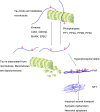Advances in the pathogenesis of Alzheimer's disease: focusing on tau-mediated neurodegeneration
- PMID: 23241453
- PMCID: PMC3598890
- DOI: 10.1186/2047-9158-1-24
Advances in the pathogenesis of Alzheimer's disease: focusing on tau-mediated neurodegeneration
Abstract
In addition to senile plaques and cerebral amyloid angiopathy, the hyperphosphorylation of tau protein and formation of intraneuronal neurofibrillary tangles (NFTs) represents another neuropathological hallmark in AD brain. Tau is a microtubule-associated protein and localizes predominantly in the axons of neurons with the primary function in maintaining microtubules stability. When the balance between tau phosphorylation and dephosphorylation is changed in favor of the former, tau is hyperphosphorylated and the level of the free tau fractions elevated. The hyperphosphorylation of tau protein and formation of NFTs represent a characteristic neuropathological feature in AD brain. We have discussed the role of Aβ in AD in our previous review, this review focused on the recent advances in tau-mediated AD pathology, mainly including tau hyperphosphorylation, propagation of tau pathology and the relationship between tau and Aβ.
Figures

Similar articles
-
[Alzheimer disease: cellular and molecular aspects].Bull Mem Acad R Med Belg. 2005;160(10-12):445-9; discussion 450-1. Bull Mem Acad R Med Belg. 2005. PMID: 16768248 French.
-
Current advances on different kinases involved in tau phosphorylation, and implications in Alzheimer's disease and tauopathies.Curr Alzheimer Res. 2005 Jan;2(1):3-18. doi: 10.2174/1567205052772713. Curr Alzheimer Res. 2005. PMID: 15977985 Review.
-
Accumulated amyloid-beta peptide and hyperphosphorylated tau protein: relationship and links in Alzheimer's disease.J Alzheimers Dis. 2009;16(1):15-27. doi: 10.3233/JAD-2009-0960. J Alzheimers Dis. 2009. PMID: 19158417 Review.
-
Mechanisms of neurofibrillary degeneration and the formation of neurofibrillary tangles.J Neural Transm Suppl. 1998;53:169-80. doi: 10.1007/978-3-7091-6467-9_15. J Neural Transm Suppl. 1998. PMID: 9700655 Review.
-
Pathological Tau From Alzheimer's Brain Induces Site-Specific Hyperphosphorylation and SDS- and Reducing Agent-Resistant Aggregation of Tau in vivo.Front Aging Neurosci. 2019 Mar 5;11:34. doi: 10.3389/fnagi.2019.00034. eCollection 2019. Front Aging Neurosci. 2019. PMID: 30890929 Free PMC article.
Cited by
-
Plasma phosphorylated tau181 as a biomarker of mild traumatic brain injury: findings from THINC and NCAA-DoD CARE Consortium prospective cohorts.Front Neurol. 2023 Aug 17;14:1202967. doi: 10.3389/fneur.2023.1202967. eCollection 2023. Front Neurol. 2023. PMID: 37662031 Free PMC article.
-
Geniposide ameliorates learning memory deficits, reduces tau phosphorylation and decreases apoptosis via GSK3β pathway in streptozotocin-induced alzheimer rat model.Brain Pathol. 2014 Apr;24(3):261-9. doi: 10.1111/bpa.12116. Epub 2014 Feb 12. Brain Pathol. 2014. PMID: 24329968 Free PMC article.
-
Behavioral and psychological symptoms in Alzheimer's disease.Biomed Res Int. 2014;2014:927804. doi: 10.1155/2014/927804. Epub 2014 Jul 15. Biomed Res Int. 2014. PMID: 25133184 Free PMC article. Review.
-
Protective Effects of Bifidobacterium Breve MCC1274 as a Novel Therapy for Alzheimer's Disease.Nutrients. 2025 Jan 31;17(3):558. doi: 10.3390/nu17030558. Nutrients. 2025. PMID: 39940416 Free PMC article. Review.
-
Altered Regulation of KIAA0566, and Katanin Signaling Expression in the Locus Coeruleus With Neurofibrillary Tangle Pathology.Front Cell Neurosci. 2018 May 17;12:131. doi: 10.3389/fncel.2018.00131. eCollection 2018. Front Cell Neurosci. 2018. PMID: 29867364 Free PMC article.
References
LinkOut - more resources
Full Text Sources

